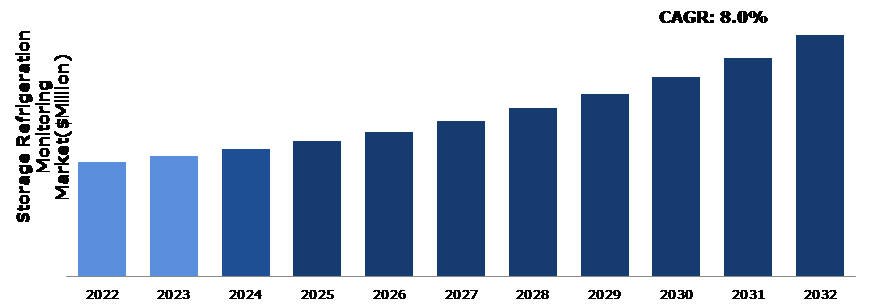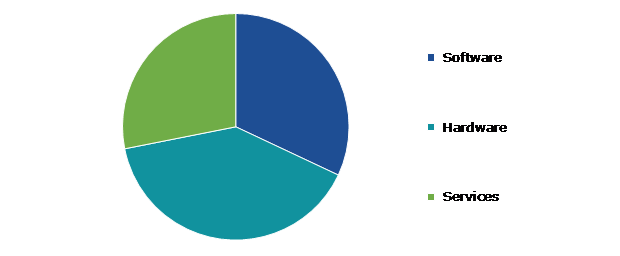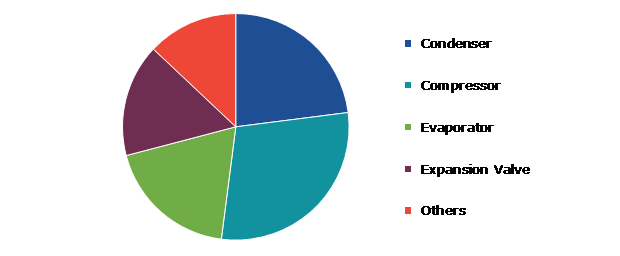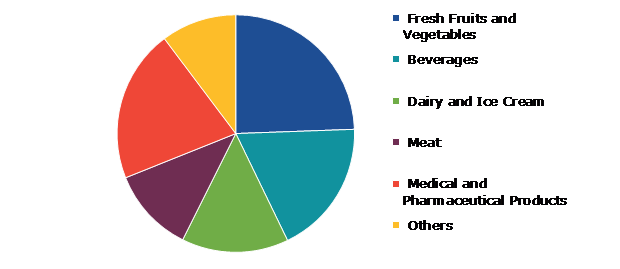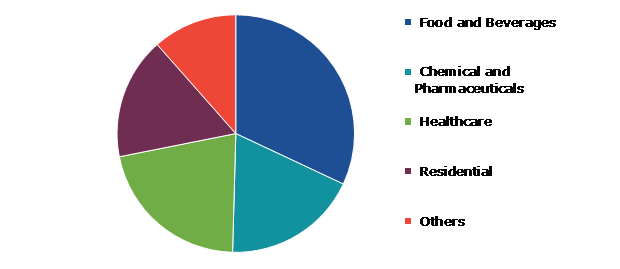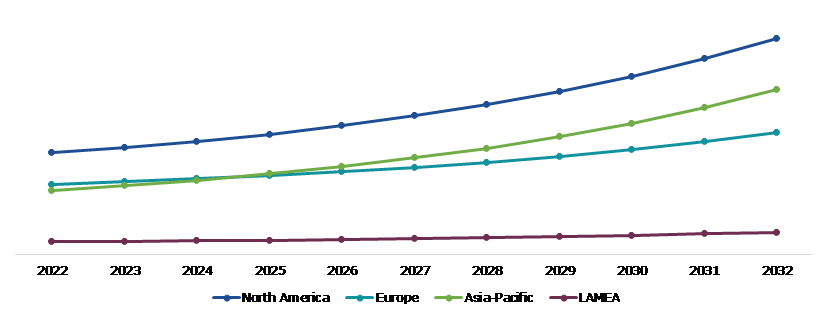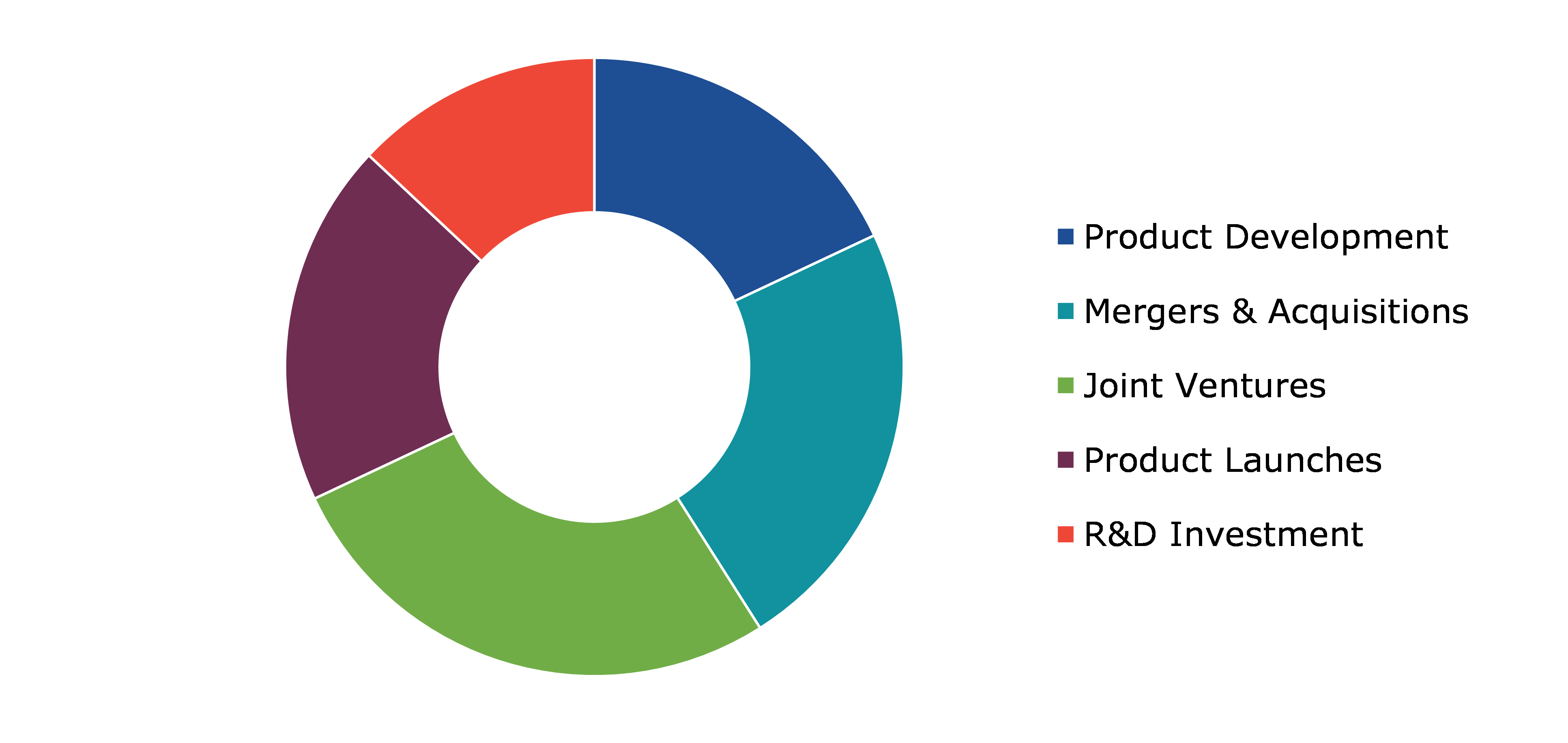Global Storage Refrigeration Monitoring Market Report
RA00169
Global Storage Refrigeration Monitoring Market by System Type (Software, Hardware, and Services), Component (Condenser, Compressor, Evaporator, Expansion Valve, and Others), Storage Application (Fresh Fruits & Vegetables, Beverages, Dairy & Ice Cream, Meat, Medical & Pharmaceutical Products, and Others), End-use Industry (Food & Beverages, Chemical & Pharmaceuticals, Healthcare, Residential, and Others), and Region (North America, Europe, Asia-Pacific, and LAMEA): Opportunity Analysis and Industry Forecast, 2023-2032
Update Available On-Demand
Storage Refrigeration Monitoring Overview
Storage refrigeration monitoring refers to the system actively monitoring and managing the temperature and other prerequisites inside a storage or refrigeration system. It includes the use of sensors, information logging devices, and monitoring software programs to constantly acquire and analyze data related to temperature, humidity, pressure, and other applicable parameters. The main reason for storage refrigeration monitoring is to make sure the most effective and safe storage of perishable goods, such as food, pharmaceuticals, vaccines, and different temperature-sensitive products.
Monitoring systems frequently provide real-time alerts and notifications to responsible personnel when temperature or different parameters go beyond predetermined thresholds. This allows for immediate corrective actions to be taken, such as adjusting the cooling settings, repairing misguided equipment, or relocating the perishable goods to an extraordinary storage unit. Accurate and dependable storage refrigeration monitoring helps forestall spoilage, maintain product quality, and ensure compliance with enterprise rules and standards. It also plays a crucial function in reducing power consumption and running costs by optimizing cooling efficiency and detecting and addressing equipment malfunctions or inefficiencies.
Global Storage Refrigeration Monitoring Market Analysis
The Global Storage Refrigeration Monitoring Market Size was $8,338.2 million in 2022 and is predicted to grow with a CAGR of 8.0%, by generating a revenue of $17,569.4 million by 2032.
Source: Research Dive Analysis
COVID-19 Impact on Global Storage Refrigeration Monitoring Market
The COVID-19 impact on storage refrigeration monitoring market has had a significant impact on various industries, including the storage refrigeration monitoring market. The storage and transportation of vaccines, medicines, and perishable food items became critical during the pandemic. Therefore, there had been a surge in demand for cold storage services and refrigeration monitoring systems to keep the required temperature and make sure product safety. Remote monitoring and management of refrigeration systems became essential due to lockdowns and social distancing measures in place. Advanced monitoring technologies, such as IoT-enabled sensors and cloud-based platforms, received prominence as they allowed real-time monitoring and control of refrigeration devices without physical presence. The pandemic highlighted the significance of maintaining food safety and quality standards. Refrigeration monitoring systems play an essential role in ensuring the most useful storage conditions, preventing food spoilage, and minimizing product losses. Consequently, there has been an increased focus on implementing strong monitoring solutions to comply with food security regulations.
The global supply chain faced significant disruptions due to lockdowns, travel restrictions, and reduced manufacturing capacities. These disruptions impacted the availability and transportation of perishable goods, leading to a greater need for appropriate monitoring of storage conditions to reduce product wastage. To minimize the chance of virus transmission, organizations, and businesses increasingly adopted contactless technologies. This shift impacted the storage refrigeration monitoring market, leading to a larger demand for touchless temperature sensors, automated information logging, and remote-control systems.
Increasing Focus on Food Quality to Drive the Market Growth
The increasing focus on food quality and extending the shelf life of perishable products is certainly a major driver for the rising demand for specific monitoring of storage refrigeration conditions. Maintaining the greatest storage refrigeration conditions is essential for preventing spoilage and reducing food waste. Precise monitoring of temperature, humidity, and other environmental factors ensures that perishable products are stored under the best conditions, minimizing the risk of bacterial growth, enzymatic reactions, and different processes that can lead to spoilage. By implementing storage refrigeration monitoring systems, agencies can become aware of and rectify any deviations from the required storage specifications promptly, thereby reducing the chances of product spoilage and minimizing food waste. Precise monitoring of storage refrigeration conditions helps to keep the high-quality and freshness of perishable products. Factors such as temperature, humidity, and air circulation can significantly affect the quality and sensory attributes of food items. By carefully monitoring and controlling these factors, agencies can make sure that products remain fresh, flavorful, and visually appealing for an extended period. This is, in particular, necessary for industries like food retail, restaurants, and pharmaceuticals, where maintaining product quality is at once linked to customer satisfaction and brand reputation. The rising focus on food quality, extended shelf life, regulatory compliance, and operational effectiveness are all driving the adoption of the storage refrigeration monitoring systems.
To know more about global storage refrigeration monitoring market drivers, get in touch with our analysts here.
High Initial Investment to Restrain the Market Growth
The high initial investment is expected to be a major restraint for the storage refrigeration monitoring market growth. Implementing a complete storage refrigeration monitoring system involves the purchase of specialized equipment such as temperature sensors, humidity sensors, data loggers, and monitoring devices. These devices can be expensive, particularly if a large number of sensors are required to monitor multiple storage units. In addition to the cost of equipment, there are installation and set-up expenses involved in implementing a monitoring system. This may additionally include hiring technicians or consultants to install the sensors, connect them to the monitoring system, and integrate the software with existing infrastructure. These costs can further add to the initial investment required. Along with hardware costs, there are software expenses to consider. Monitoring structures regularly require dedicated software systems to acquire and analyze data from the sensors. Acquiring and licensing excellent software can be a significant expense, in particular for corporations with restrained budgets, which is expected to hamper the storage refrigeration monitoring market growth.
Technical Advancements in the Software Systems and Rising Demand for Cold Storage to Drive Excellent Opportunities
The storage refrigeration monitoring market trend benefits from ongoing technological advancements. Innovations such as the Internet of Things (IoT), cloud computing, and wireless communication have enabled the development of smart monitoring systems. These systems can provide real-time monitoring, facts analysis, and remote control of refrigeration units, offering increased efficiency, accuracy, and convenience. The integration of emerging technologies opens up new possibilities for enhancing storage refrigeration management. Moreover, the rising demand for cold storage services in the global food & beverage industry offers significant opportunities for the storage refrigeration monitoring market. The expansion of the food & beverage industry, along with changing customer preferences and the growth of the e-commerce sector, is driving the demand for cold storage facilities. This demand creates a want for advanced storage refrigeration monitoring solutions to maintain top-quality temperature conditions, monitor performance, and make sure the safety and quality of perishable goods. Storage refrigeration monitoring solutions play an essential role in continuously monitoring temperature levels, humidity, and different essential parameters. By offering real-time signals and notifications, these solutions help prevent spoilage, reduce waste, and ensure compliance with regulatory standards.
To know more about global storage refrigeration monitoring market opportunities, get in touch with our analysts here.
Global Storage Refrigeration Monitoring Market Share, by System Type, 2022
Source: Research Dive Analysis
The hardware sub-segment accounted for the highest market share in 2022. This is because hardware components play an important role in the control and monitoring of refrigeration systems in cold storage and transportation units. Temperature and pressure sensors, RFID devices, networking devices, telematics and telemetry devices, and other modules are all part of hardware systems. Temperature, for example, is one of the main characteristics that must be monitored and regulated in a variety of applications such as food & beverages, transportation, pharmaceuticals, and others. All these factors are predicted to drive the hardware sub-segment growth during the forecast period.
Global Storage Refrigeration Monitoring Market Size, by Component, 2022
Source: Research Dive Analysis
The compressor sub-segment accounted for the highest market share in 2022. This expected dominance is attributed to compressors being extensively used in air conditioning units in both industrial & residential refrigeration network applications including humidifiers, chillers, and others. A compressor is a mechanical device that increases the pressure of a gas by reducing its volume. Additionally, compressor is one of the main instruments in refrigeration systems that extracts heat from inside of refrigerator and cools it by refrigerants These aforementioned factors are estimated to drive the demand for compressors in the refrigeration system, consequently driving the market growth.
Global Storage Refrigeration Monitoring Market Growth, by Storage Application, 2022
Source: Research Dive Analysis
The fresh fruits & vegetables sub-segment accounted for the highest market share in 2022. This growth is due to the increasing popularity of refrigerated systems for fruit & vegetable storage, which require a consistent temperature during the chilling and maintenance procedures. Furthermore, the majority of food processing enterprises use freezing systems while processing vegetables and fruits, which is expected to drive the segment growth during the forecast period.
Global Storage Refrigeration Monitoring Market Analysis, by End-use Industry, 2022
Source: Research Dive Analysis
The food & beverages sub-segment accounted for the highest market share in 2022. This expansion is primarily due to the widespread use of refrigeration components in food & beverage applications. The well-organized monitoring and maintenance of storage refrigeration networks is critical for the safety, durability, and quality of food & beverage items. Furthermore, rising global demand for frozen and packaged food items is expected to boost the segment expansion in the upcoming years.
Global Storage Refrigeration Monitoring Market Size & Forecast, by Region, 2022-2032 ($Million)
Source: Research Dive Analysis
The North America storage refrigeration monitoring market generated the highest revenue in 2022. The increase in demand for chilled and frozen food products by customers is attributed for the expansion of the North America market. The development of storage refrigeration monitoring systems is also projected to be aided by the region's developed healthcare infrastructure. The region holds a significant market share due to the rising need for temperature monitors from food storage facilities and food logistics operators. Consumer food patterns are changing owing to the increasing rate of obesity in this region. People are becoming more inclined to favor consumption of fresh and organic food, which requires careful handling and monitoring at each stage of storage and transit to prevent rotting.
Competitive Scenario in the Global Storage Refrigeration Monitoring Market
Investment and agreement are common strategies followed by major market players. For instance, in May 2022, Vertical Cold Storage, a major provider of temperature-controlled distribution centers, announced the purchase of three public refrigerated warehouses from the U.S. Cold Storage in order to improve its position in several rapidly rising markets. This strategic purchase will also assist the company in expanding its refrigerated meat, poultry, seafood, and protein operations.
Source: Research Dive Analysis
Some of the leading storage refrigeration monitoring market analysis players are Emerson Electric Co., Johnson Controls, MAYEKAWA MFG. CO., LTD, United Technologies, Sensitech Inc., DAIKIN INDUSTRIES, Ltd, EVAPCO, Inc., GEA Group Aktiengesellschaft, Ingersoll Rand, and LU-VE S.p.A.
| Aspect | Particulars |
| Historical Market Estimations | 2020-2021 |
| Base Year for Market Estimation | 2022 |
| Forecast Timeline for Market Projection | 2023-2032 |
| Geographical Scope | North America, Europe, Asia-Pacific, and LAMEA |
| Segmentation by System Type |
|
| Segmentation by Component |
|
|
Segmentation by Storage Application
|
|
|
|
|
| Key Companies Profiled |
|
Q1. What is the size of the global storage refrigeration monitoring market?
A. The global storage refrigeration monitoring market size was over $ 8,338.2 million in 2022 and is projected to reach $ 17,569.4 million by 2032.
Q2. Which are the major companies in the storage refrigeration monitoring market?
A. Emerson Electric Co., Johnson Controls, and MAYEKAWA MFG. CO., LTD are some of the key players in the global storage refrigeration monitoring market.
Q3. Which region, among others, possesses greater investment opportunities in the future?
A. Asia-Pacific possesses great investment opportunities for investors in the future.
Q4. What will be the growth rate of the Asia-Pacific storage refrigeration monitoring market?
A. Asia-Pacific storage refrigeration monitoring market share is anticipated to grow at 10.2% CAGR during the forecast period.
Q5. What are the strategies opted by the leading players in this market?
A. Agreement and investment are the two key strategies opted by the operating companies in this market.
Q6. Which companies are investing more on R&D practices?
A. Emerson Electric Co., Johnson Controls, and MAYEKAWA MFG. CO., LTD are the companies investing more on R&D activities for developing new products and technologies.
1.Research Methodology
1.1.Desk Research
1.2.Real time insights and validation
1.3.Forecast model
1.4.Assumptions and forecast parameters
1.5.Market size estimation
1.5.1.Top-down approach
1.5.2.Bottom-up approach
2.Report Scope
2.1.Market definition
2.2.Key objectives of the study
2.3.Report overview
2.4.Market segmentation
2.5.Overview of the impact of COVID-19 on Global Storage Refrigeration Monitoring Market
3.Executive Summary
4.Market Overview
4.1.Introduction
4.2.Growth impact forces
4.2.1.Drivers
4.2.2.Restraints
4.2.3.Opportunities
4.3.Market value chain analysis
4.3.1.List of raw material suppliers
4.3.2.List of manufacturers
4.3.3.List of distributors
4.4.Innovation & sustainability matrices
4.4.1.Technology matrix
4.4.2.Regulatory matrix
4.5.Porter’s five forces analysis
4.5.1.Bargaining power of suppliers
4.5.2.Bargaining power of consumers
4.5.3.Threat of substitutes
4.5.4.Threat of new entrants
4.5.5.Competitive rivalry intensity
4.6.PESTLE analysis
4.6.1.Political
4.6.2.Economical
4.6.3.Social
4.6.4.Technological
4.6.5.Environmental
4.7.Impact of COVID-19 on Storage Refrigeration Monitoring market
4.7.1.Pre-covid market scenario
4.7.2.Post-covid market scenario
5.Storage Refrigeration Monitoring Market, by System Type
5.1.Overview
5.1.1.Market size and forecast, by System Type
5.2.Software
5.2.1.Key market trends, growth factors, and opportunities
5.2.2.Market size and forecast, by region, 2022-2032
5.2.3.Market share analysis, by country 2022 & 2032
5.3.Hardware
5.3.1.Key market trends, growth factors, and opportunities
5.3.2.Market size and forecast, by region, 2022-2032
5.3.3.Market share analysis, by country 2022 & 2032
5.4.Services
5.4.1.Key market trends, growth factors, and opportunities
5.4.2.Market size and forecast, by region, 2022-2032
5.4.3.Market share analysis, by country 2022 & 2032
5.5.Research Dive Exclusive Insights
5.5.1.Market attractiveness
5.5.2.Competition heatmap
6.Storage Refrigeration Monitoring Market, by Component
6.1.Overview
6.1.1.Market size and forecast, by Component
6.2.Condenser
6.2.1.Key market trends, growth factors, and opportunities
6.2.2.Market size and forecast, by region, 2022-2032
6.2.3.Market share analysis, by country 2022 & 2032
6.3.Compressor
6.3.1.Key market trends, growth factors, and opportunities
6.3.2.Market size and forecast, by region, 2022-2032
6.3.3.Market share analysis, by country 2022 & 2032
6.4.Evaporator
6.4.1.Key market trends, growth factors, and opportunities
6.4.2.Market size and forecast, by region, 2022-2032
6.4.3.Market share analysis, by country 2022 & 2032
6.5.Expansion Valve
6.5.1.Key market trends, growth factors, and opportunities
6.5.2.Market size and forecast, by region, 2022-2032
6.5.3.Market share analysis, by country 2022 & 2032
6.6.Others
6.6.1.Key market trends, growth factors, and opportunities
6.6.2.Market size and forecast, by region, 2022-2032
6.6.3.Market share analysis, by country 2022 & 2032
6.7.Research Dive Exclusive Insights
6.7.1.Market attractiveness
6.7.2.Competition heatmap
7.Storage Refrigeration Monitoring Market, by Storage Application
7.1.Overview
7.1.1.Market size and forecast, by Storage Application
7.2.Fresh Fruits & Vegetables
7.2.1.Key market trends, growth factors, and opportunities
7.2.2.Market size and forecast, by region, 2022-2032
7.2.3.Market share analysis, by country 2022 & 2032
7.3.Beverages
7.3.1.Key market trends, growth factors, and opportunities
7.3.2.Market size and forecast, by region, 2022-2032
7.3.3.Market share analysis, by country 2022 & 2032
7.4.Dairy & Ice Cream
7.4.1.Key market trends, growth factors, and opportunities
7.4.2.Market size and forecast, by region, 2022-2032
7.4.3.Market share analysis, by country 2022 & 2032
7.5.Meat
7.5.1.Key market trends, growth factors, and opportunities
7.5.2.Market size and forecast, by region, 2022-2032
7.5.3.Market share analysis, by country 2022 & 2032
7.6.Medical & Pharmaceutical Products
7.6.1.Key market trends, growth factors, and opportunities
7.6.2.Market size and forecast, by region, 2022-2032
7.6.3.Market share analysis, by country 2022 & 2032
7.7.Others
7.7.1.Key market trends, growth factors, and opportunities
7.7.2.Market size and forecast, by region, 2022-2032
7.7.3.Market share analysis, by country 2022 & 2032
7.8.Research Dive Exclusive Insights
7.8.1.Market attractiveness
7.8.2.Competition heatmap
8.Storage Refrigeration Monitoring Market, by End-use Industry
8.1.Overview
8.1.1.Market size and forecast, by End-use Industry
8.2.Food & Beverages
8.2.1.Key market trends, growth factors, and opportunities
8.2.2.Market size and forecast, by region, 2022-2032
8.2.3.Market share analysis, by country 2022 & 2032
8.3.Chemical & Pharmaceuticals
8.3.1.Key market trends, growth factors, and opportunities
8.3.2.Market size and forecast, by region, 2022-2032
8.3.3.Market share analysis, by country 2022 & 2032
8.4.Healthcare
8.4.1.Key market trends, growth factors, and opportunities
8.4.2.Market size and forecast, by region, 2022-2032
8.4.3.Market share analysis, by country 2022 & 2032
8.5.Residential
8.5.1.Key market trends, growth factors, and opportunities
8.5.2.Market size and forecast, by region, 2022-2032
8.5.3.Market share analysis, by country 2022 & 2032
8.6.Others
8.6.1.Key market trends, growth factors, and opportunities
8.6.2.Market size and forecast, by region, 2022-2032
8.6.3.Market share analysis, by country 2022 & 2032
8.7.Research Dive Exclusive Insights
8.7.1.Market attractiveness
8.7.2.Competition heatmap
9.Storage Refrigeration Monitoring Market, by Region
9.1.North America
9.1.1.U.S.
9.1.1.1.Market size analysis, by System Type, 2022-2032
9.1.1.2.Market size analysis, by Component, 2022-2032
9.1.1.3.Market size analysis, by Storage Application, 2022-2032
9.1.1.4.Market size analysis, by End-use Industry, 2022-2032
9.1.2.Canada
9.1.2.1.Market size analysis, by System Type, 2022-2032
9.1.2.2.Market size analysis, by Component, 2022-2032
9.1.2.3.Market size analysis, by Storage Application, 2022-2032
9.1.2.4.Market size analysis, by End-use Industry, 2022-2032
9.1.3.Mexico
9.1.3.1.Market size analysis, by System Type, 2022-2032
9.1.3.2.Market size analysis, by Component, 2022-2032
9.1.3.3.Market size analysis, by Storage Application, 2022-2032
9.1.3.4.Market size analysis, by End-use Industry, 2022-2032
9.1.4.Research Dive Exclusive Insights
9.1.4.1.Market attractiveness
9.1.4.2.Competition heatmap
9.2.Europe
9.2.1.Germany
9.2.1.1.Market size analysis, by System Type, 2022-2032
9.2.1.2.Market size analysis, by Component, 2022-2032
9.2.1.3.Market size analysis, by Storage Application, 2022-2032
9.2.1.4.Market size analysis, by End-use Industry, 2022-2032
9.2.2.UK
9.2.2.1.Market size analysis, by System Type, 2022-2032
9.2.2.2.Market size analysis, by Component, 2022-2032
9.2.2.3.Market size analysis, by Storage Application, 2022-2032
9.2.2.4.Market size analysis, by End-use Industry, 2022-2032
9.2.3.France
9.2.3.1.Market size analysis, by System Type, 2022-2032
9.2.3.2.Market size analysis, by Component, 2022-2032
9.2.3.3.Market size analysis, by Storage Application, 2022-2032
9.2.3.4.Market size analysis, by End-use Industry, 2022-2032
9.2.4.Spain
9.2.4.1.Market size analysis, by System Type, 2022-2032
9.2.4.2.Market size analysis, by Component, 2022-2032
9.2.4.3.Market size analysis, by Storage Application, 2022-2032
9.2.4.4.Market size analysis, by End-use Industry, 2022-2032
9.2.5.Italy
9.2.5.1.Market size analysis, by System Type, 2022-2032
9.2.5.2.Market size analysis, by Component, 2022-2032
9.2.5.3.Market size analysis, by Storage Application, 2022-2032
9.2.5.4.Market size analysis, by End-use Industry, 2022-2032
9.2.6.Rest of Europe
9.2.6.1.Market size analysis, by System Type, 2022-2032
9.2.6.2.Market size analysis, by Component, 2022-2032
9.2.6.3.Market size analysis, by Storage Application, 2022-2032
9.2.6.4.Market size analysis, by End-use Industry, 2022-2032
9.2.7.Research Dive Exclusive Insights
9.2.7.1.Market attractiveness
9.2.7.2.Competition heatmap
9.3.Asia-Pacific
9.3.1.China
9.3.1.1.Market size analysis, by System Type, 2022-2032
9.3.1.2.Market size analysis, by Component, 2022-2032
9.3.1.3.Market size analysis, by Storage Application, 2022-2032
9.3.1.4.Market size analysis, by End-use Industry, 2022-2032
9.3.2.Japan
9.3.2.1.Market size analysis, by System Type, 2022-2032
9.3.2.2.Market size analysis, by Component, 2022-2032
9.3.2.3.Market size analysis, by Storage Application, 2022-2032
9.3.2.4.Market size analysis, by End-use Industry, 2022-2032
9.3.3.India
9.3.3.1.Market size analysis, by System Type, 2022-2032
9.3.3.2.Market size analysis, by Component, 2022-2032
9.3.3.3.Market size analysis, by Storage Application, 2022-2032
9.3.3.4.Market size analysis, by End-use Industry, 2022-2032
9.3.4.Australia
9.3.4.1.Market size analysis, by System Type, 2022-2032
9.3.4.2.Market size analysis, by Component, 2022-2032
9.3.4.3.Market size analysis, by Storage Application, 2022-2032
9.3.4.4.Market size analysis, by End-use Industry, 2022-2032
9.3.5.South Korea
9.3.5.1.Market size analysis, by System Type, 2022-2032
9.3.5.2.Market size analysis, by Component, 2022-2032
9.3.5.3.Market size analysis, by Storage Application, 2022-2032
9.3.5.4.Market size analysis, by End-use Industry, 2022-2032
9.3.6.Rest of Asia-Pacific
9.3.6.1.Market size analysis, by System Type, 2022-2032
9.3.6.2.Market size analysis, by Component, 2022-2032
9.3.6.3.Market size analysis, by Storage Application, 2022-2032
9.3.6.4.Market size analysis, by End-use Industry, 2022-2032
9.3.7.Research Dive Exclusive Insights
9.3.7.1.Market attractiveness
9.3.7.2.Competition heatmap
9.4.LAMEA
9.4.1.Brazil
9.4.1.1.Market size analysis, by System Type, 2022-2032
9.4.1.2.Market size analysis, by Component, 2022-2032
9.4.1.3.Market size analysis, by Storage Application, 2022-2032
9.4.1.4.Market size analysis, by End-use Industry, 2022-2032
9.4.2.Saudi Arabia
9.4.2.1.Market size analysis, by System Type, 2022-2032
9.4.2.2.Market size analysis, by Component, 2022-2032
9.4.2.3.Market size analysis, by Storage Application, 2022-2032
9.4.2.4.Market size analysis, by End-use Industry, 2022-2032
9.4.3.UAE
9.4.3.1.Market size analysis, by System Type, 2022-2032
9.4.3.2.Market size analysis, by Component, 2022-2032
9.4.3.3.Market size analysis, by Storage Application, 2022-2032
9.4.3.4.Market size analysis, by End-use Industry, 2022-2032
9.4.4.South Africa
9.4.4.1.Market size analysis, by System Type, 2022-2032
9.4.4.2.Market size analysis, by Component, 2022-2032
9.4.4.3.Market size analysis, by Storage Application, 2022-2032
9.4.4.4.Market size analysis, by End-use Industry, 2022-2032
9.4.5.Rest of LAMEA
9.4.5.1.Market size analysis, by System Type, 2022-2032
9.4.5.2.Market size analysis, by Component, 2022-2032
9.4.5.3.Market size analysis, by Storage Application, 2022-2032
9.4.5.4.Market size analysis, by End-use Industry, 2022-2032
9.4.6.Research Dive Exclusive Insights
9.4.6.1.Market attractiveness
9.4.6.2.Competition heatmap
10.Competitive Landscape
10.1.Top winning strategies, 2022
10.1.1.By strategy
10.1.2.By year
10.2.Strategic overview
10.3.Market share analysis, 2022
11.Company Profiles
11.1.Emerson Electric Co.
11.1.1.Overview
11.1.2.Business segments
11.1.3.Product portfolio
11.1.4.Financial performance
11.1.5.Recent developments
11.1.6.SWOT analysis
11.2.Johnson Controls
11.2.1.Overview
11.2.2.Business segments
11.2.3.Product portfolio
11.2.4.Financial performance
11.2.5.Recent developments
11.2.6.SWOT analysis
11.3.MAYEKAWA MFG. CO., LTD
11.3.1.Overview
11.3.2.Business segments
11.3.3.Product portfolio
11.3.4.Financial performance
11.3.5.Recent developments
11.3.6.SWOT analysis
11.4.United Technologies
11.4.1.Overview
11.4.2.Business segments
11.4.3.Product portfolio
11.4.4.Financial performance
11.4.5.Recent developments
11.4.6.SWOT analysis
11.5.Sensitech Inc.
11.5.1.Overview
11.5.2.Business segments
11.5.3.Product portfolio
11.5.4.Financial performance
11.5.5.Recent developments
11.5.6.SWOT analysis
11.6.DAIKIN INDUSTRIES, Ltd
11.6.1.Overview
11.6.2.Business segments
11.6.3.Product portfolio
11.6.4.Financial performance
11.6.5.Recent developments
11.6.6.SWOT analysis
11.7.EVAPCO, Inc.
11.7.1.Overview
11.7.2.Business segments
11.7.3.Product portfolio
11.7.4.Financial performance
11.7.5.Recent developments
11.7.6.SWOT analysis
11.8.GEA Group Aktiengesellschaft
11.8.1.Overview
11.8.2.Business segments
11.8.3.Product portfolio
11.8.4.Financial performance
11.8.5.Recent developments
11.8.6.SWOT analysis
11.9.Ingersoll Rand
11.9.1.Overview
11.9.2.Business segments
11.9.3.Product portfolio
11.9.4.Financial performance
11.9.5.Recent developments
11.9.6.SWOT analysis
11.10.LU-VE S.p.A.
11.10.1.Overview
11.10.2.Business segments
11.10.3.Product portfolio
11.10.4.Financial performance
11.10.5.Recent developments
11.10.6.SWOT analysis
Refrigeration is a procedure of freezing or eliminating heat from a substance or an enclosed space or forcontrolling and lowering the temperature. This can be done by artificial cooling systems such as refrigerator, freezers, chillers, and coolers. The storage refrigeration system comprises of several components that includes metering device, evaporator, condenser, and compressor.
Storage refrigeration monitoring systems generate real-time alerts for fluctuations in temperature and also automatically monitors the temperature in the storage refrigeration systems. As the storage refrigeration monitoring systems are made up of advanced IoT(Internet of Things) sensor technology, they provide facilities like motion detection, humidity sensing, water detection, real-time alerts, wireless temperature control, etc. As per Research Dive blog, these systems are used for both storage as well as transportation purposes and lowers the production of bacteria. Due to several benefits associated with these systems, they are used majorly in the several industries including healthcare, food& beverages, chemical & pharmaceutical, and others to minimize the spoilage by preserve the essential items.
Recent Developments in the Industry
The storage refrigeration systems provide reliable and accurate temperature monitoring. Many industry players are now moving towards IoT to provide consumers with improved quality and reduced product waste. The players are now designing the storage refrigeration systems with advanced technology to reduce errors and time spent on noting manual readings. For instance, the UK-based Hanwell Solution Limited has launched a new product namely ‘Notion Lite’. This storage refrigeration system is wireless and is used in monitoring temperature of medical supplies and food for healthcare and food retailers such as high street pharmacies, Vets, Butchers, restaurants etc.
In April 2016, Daikin Industries, Ltd. through its subsidiary decided to acquire an Italy-based manufacturer of freezers &refrigerators,Zanotti S.p.A. at 98 million euros. The focus ofDaikin was to expand its freezer & refrigerators business in the Europe region. The acquisition was completed later in June 2016.
In May 2017, Daikin Industries, Ltd., launched the R-407H refrigerant system, which has around 62% lower GWP (global warming potential) than frequently used R-404A storage refrigeration system.A high GWP refrigeration system is widely used as a refrigeration equipment in marine vessel, warehouse, supermarket, and other industrial applications.
Forecast Analysis of Storage Refrigeration Monitoring Industry
Global storage refrigeration monitoring market is estimated to witness a positive growth during the forecast period. Continuous technical progressions in RFIDs for effective monitoring of software components in the refrigeration units is creating massive opportunities for the global market. Growing trend towards IoT is also predicted to drive the market growth from 2019 to 2026. However, stringent regulations on the usage of coolants and high installation & maintenance costs are considered to be the major factors restricting the growth of agriculture robot market.
Increasing consumption of fast moving consumer goods, along with rising number of meat consumers across the globe are some of the significant factors giving substantial uplift to the growth of storage refrigeration monitoring market in the near future. As per the Research Dive report statistics, the storage refrigeration monitoring market is expected to reach up to $$7,227.5 million by the end of 2026. Geographically, the Asia Pacific market is likely to create growth opportunities for market vendors owing to wide usage of storage refrigeration systems by end use industry verticals to store the products such as pharmaceutical medicines, processed foods and other applications. In addition, the report profiles prominent players operating in the global market who are focusing more R&D activities and product development to increase their market size in the global industry.
Personalize this research
- Triangulate with your own data
- Request your format and definition
- Get a deeper dive on a specific application, geography, customer or competitor
- + 1-888-961-4454 Toll - Free
- support@researchdive.com

